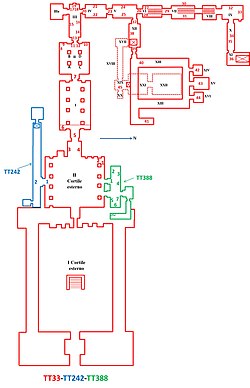| Theban tomb TT33 | |
|---|---|
| Burial site of Padiamenope | |
 | |
| Location | El-Assasif, Theban Necropolis |
| Discovered | Prior to 1737 |
| ← Previous TT32Next → TT34 | |
| ||||||
| Pediamenopet in hieroglyphs | ||||||
|---|---|---|---|---|---|---|
| Era: New Kingdom (1550–1069 BC) | ||||||

The Theban Tomb TT33 is an ancient Egyptian tomb. Located in El-Assasif, it is part of the Theban Necropolis on the west bank of the Nile, opposite to Luxor. The tomb is the burial place of the ancient Egyptian Padiamenope, who was Prophet and Chief Lector Priest during the 26th Dynasty.
Although it was open when Richard Pocoke visited the area in 1737 (he thought it was a subterranean palace) it was more fully examined and excavated in 1881 by Johannes Dümichen from the University of Strasbourg. Located not far from Deir el-Bahari, it is larger than most of the more famous pharaohs' tombs that are found in the necropolis. It is composed of twenty-two rooms connected by long corridors and distributed on three levels extending twenty metres below the level of the ground.
The tomb owner served one or more pharaohs during the 25th to 26th Dynasty time period, and amassed enough wealth and power to build a labyrinthine tomb covered with hundreds of metres of frescoes and hieroglyphs.
The tomb was and still remains the largest known non-royal site in the necropolis as of 2008. TT33 consists of 22 rooms, reached by flights of steps, ramps and vertical shafts.
During 2004–2005, a joint team from the IFAO (French Institute of Oriental Archaeology, Cairo, Egypt) and the University of Strasbourg explored the chambers of the huge tomb. The official reopening was attended by notable officials from Egypt's Supreme Council of Antiquities and other archaeologists working in the area. Further planned work will concentrate on the cleaning, restoration and conservation of the tomb, which has been engraved with many important texts, such as Pyramid Texts, the Book of the Dead or the Great Netherworld Books (e.g. Amduat, Book of Gates and Book of Caverns.) The French Epigraphical Mission in Tomb TT 33 copies and edits the texts of the monument. It is directed by Claude Traunecker (University of Strasbourg) and Isabelle Régen (University of Montpellier 3 -\– Paul Valéry) (co-director).
Since 2018, the works of the French Archaeological Mission in Asasif (IFAO, University of Strasbourg, CNRS, under the supervision of the Egyptian Ministry of Tourism and Antiquities) revealed a significant archaeological deposit from the early 18th dynasty inside the enclosure of Padiamenope (TT 33). For example, in November of that year, 1000 ushabti and an intact sarcophagus of a female mummy called Thuya was discovered, the latter dating to the 18th Dynasty.
In October 2019, the Ministry of Antiquities announced the discovery of 30 mummies found within the vicinity of the tomb. The mummy cache consists of 23 adult males, 5 adult females, and 2 children, all of whom are assumed to be connected to Theban priesthood. The coffins were stacked on top of each other and upon opening, the mummies were found to be well preserved with their wrappings intact. Mostafa Waziri, general secretary of Supreme Council of Antiquities, stated that the tomb is the largest cache found in a century, with previous noteworthy caches being DB320, KV35, and Bab el-Gasus.
-
 Ushabtis of Pediamenopet. Museo Egizio, Turin.
Ushabtis of Pediamenopet. Museo Egizio, Turin.
See also
References
- Porter and Moss, Topographical Bibliography: The Theban Necropolis, pp. 50–56
- Baikie, James (1932). Egyptian Antiquities in the Nile Valley. Methuen.
- "Lecture: TT33 Padiamenope ala Petamenophis". 25 December 2009.
- Thomas Weidenbach (2007). La tombe 33, un mystère égyptien, Franco-Germany documentary (55 minutes).
- "Amunirdis Research weblog, 2009-02-05".
- "Tomb 33: An Egyptian Mystery". www.archaeologychannel.org. Archived from the original on 2008-07-05.
- "Opening the Tomb of Petamenophis and more". Egyptology News weblog. Dec 2005.
- Werning, Daniel A. (2019). Das Höhlenbuch im Grab des Petamenophis (TT33): Szenen, Texte, Wandtafeln. Berlin Studies of the Ancient World 66. Berlin: Edition Topoi. doi:10.17171/3-66. ISBN 978-3-9820670-0-1.
- "13th century priest's tomb discovered in Egypt's Luxor". ABC News.
- "Ancient Egyptian tomb unveiled". BBC News. 24 November 2018.
- "Live Exclusive Coverage: Dozens of Intact Ancient Egyptian Coffins and Mummies Discovered". Luxor Times. 2019-10-19. Retrieved 2019-10-21.
- History, Owen Jarus-Live Science Contributor 2019-10-19T14:26:33Z (19 October 2019). "30 Perfectly Preserved Coffins Holding Ancient Egyptian Priest Mummies Discovered". livescience.com. Retrieved 2019-10-21.
{{cite web}}:|first=has generic name (help)CS1 maint: numeric names: authors list (link) - Alaa Elassar (20 October 2019). "Egypt unveils discovery of 30 ancient coffins with mummies inside". CNN. Retrieved 2019-10-21.
Further reading
- Video (in French) « Sarcophages en contexte », 29 novembre 2020, Les rendez-vous de l'archéologie (IFE/IFAO) : https://www.youtube.com/watch?v=RyShuQtZUAQ
- Video (in French) « Des Racines & Des Ailes », 13 septembre 2017, France 3 (from 56 mn and 10 sec.) : https://www.youtube.com/watch?v=kinYx2vgdxs
- Lab notebook about French Archaeological Mission in Asasif (TT 33).
- Website of the "French Archaeological Mission in Asasif (FAMA)"
- Website of the "Mission épigraphique française dans la tombe TT 33"
- Frédéric Colin (2019), "Archéologie urbaine dans une nécropole monumentale : Assassif 2017–2018 (Ifao/Université de Strasbourg)", BSFÉ 201, 2019, p. 12–147.
- Claude Traunecker, Isabelle Régen (2016), "La tombe du prêtre Padiaménopé : éclairages nouveaux", BSFE 193–14, p. 52–83.
- Claude Traunecker, Isabelle Régen (2013), « The Funerary Palace of Padiamenope at Thebes », Egyptian Archaeology 43, p. 32–34.
25°44′05″N 32°36′44″E / 25.7346°N 32.6122°E / 25.7346; 32.6122
Category: